Every hour of practice brings your child closer to success.
So, let’s work together to ensure your child excels on the test!

Hey there! Do you have a question about the test or our practice package? Email me at roman@staggingapps.website. I'm here to help your child succeed!
The following sample questions are also available in two other formats:
Figure Matrix questions are either 2×2 or 3×3 matrices comprised of different pictures. In each row and/or column, the pictures change in the same way or follow the same rule.
Choose the answer that goes in the empty box in the matrix following the same rule.
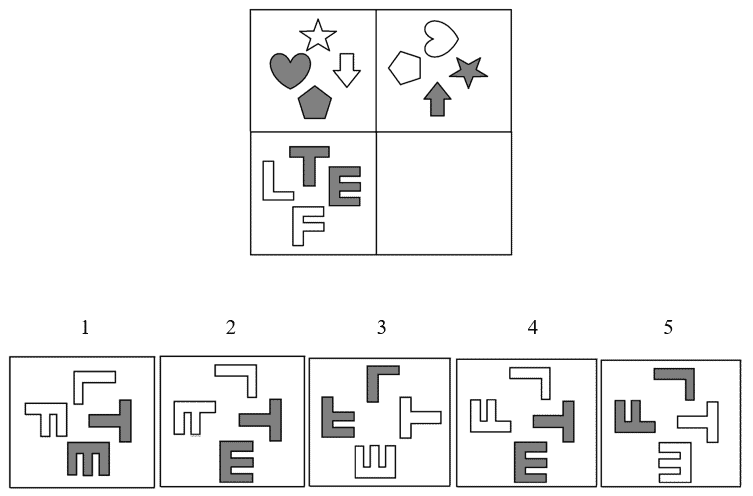
Correct answer: 3
The pattern that connects the left figure in the first row to the right one in the same row is the following:
All shapes move from the original position by making one quarter a rotation clockwise.
The grey shapes become white and vice-versa (i.e. they swap colors). The once (now grey) shapes make one-quarter a rotation anticlockwise around themselves while the once white (now grey) shapes flip vertically.
The only figure that fits this description is option 3.
Therefore, 3 is the correct answer.
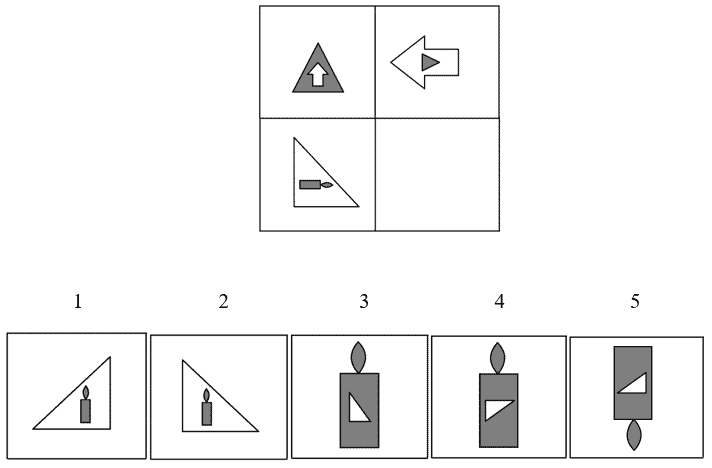
Welcome to your trusted practice resource for the 2025 CogAT 3rd Grade Test (level 9)!
To maximize your child’s scores and help them get accepted to your desired Gifted program, we have designed an effective preparation process that has helped countless students succeed:
Correct answer: 4
The pattern that connects the left figure in the first row to the right one in the same row is the following:
The inner shape becomes the outer shape and the outer shape becomes the inner shape.
Moreover, the initial outer shape makes a quarter a rotation clockwise, while the initial inner shape makes a quarter a rotation anticlockwise.
The only figure in the options that fits the description for the empty place is the 4th one.
Therefore, the correct answer is 4.
The Figure Classification questions show three pictures that share a connection or a characteristic. Choose the answer that shares the same connection/characteristic from the answer choices.
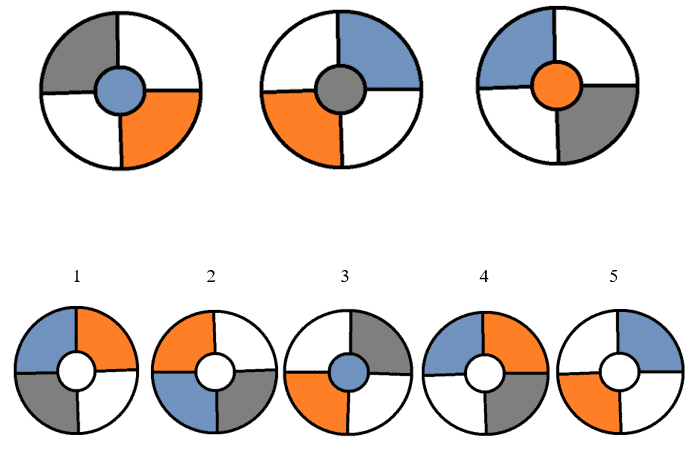
Correct answer: 3
The pattern is:
All circles contain four colors: white, orange, blue, and gray, where the small central circle is not white while two other sections around the small central circle are white, and the other two are blue and orange.
The only choice that meets this description is the 3rd one.
Each question shows a paper folded several times and then punched with holes. The answer choices contain unfolded papers with punched-in holes. You need to determine which of the answer choices is the final product of the unfolded punched-in paper.
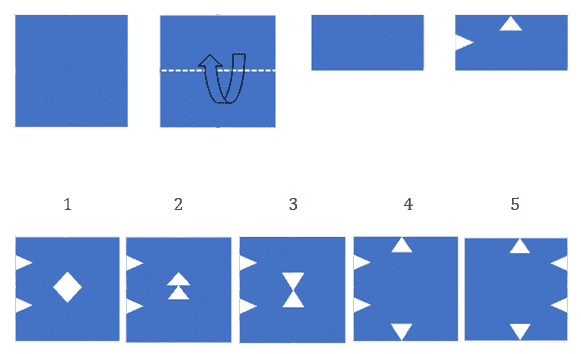
The correct answer is 4.
Nonverbal questions can be tricky, especially when students face them for the first time under time pressure. But with regular practice, your child can master them.
The more your child practices, the more confident they’ll become—and soon these questions will feel like second nature.
Our complete practice package offers over 140 CogAT Nonverbal questions, designed to sharpen skills and boost scores.
Help your child prepare with a complete practice package designed to maximize their performance on the CogAT 3rd Grade test.
Each question provides two pairs of numbers with a certain mathematical connection and another number that shares that connection with one of the answer choices. Find the missing number for the third pair.
[16 → 29] [23 → 36] [57 → ?]
A. 13
B. 45
C. 55
D. 60
E. 70
The answer is 70.
Look for the pattern in the first series of numbers. We get from 16 to 29 by adding 13 (the pattern is +13).
Likewise, we get from 23 to 36 by using the same pattern (rule) +13.
The next series of numbers should follow the same pattern, meaning that the rule between 57 and ? should be +13 as well: 57 + 13 = 70, meaning that the correct answer will be 70.
Each question provides a series of numbers that have a rule. Use the rule to determine which number will come next in the series.
5 1 8 4 11 7 18 14 21 ?
A. 17
B. 24
C. 25
D. 28
E. 31
The correct answer is 17.
In this series, the pattern is as follows: first, 4 is subtracted, then 7 is added; then again 4 is subtracted, then 7 is added, and so on.
The pattern is: -4, +7, -4, +7, …
The last two numbers in the series are 14 and 21. Since 21 is larger than 14 by 7, the next number in the series should be smaller than 21 by 4.
21 – 4 = 17
In each question you are given one or more equations. You must solve the equations to determine the number that goes instead of the question mark.
1 + ? = 4 + ♦
♦ × 2 = 6
A. 12
B. 1
C. 4
D. 2
E. 6
Correct answer: 6
Explanation:
We need to find the number that, when added to 1, will equal 4 plus ♦.
First, we need to find the value of ♦. This is what we know:
♦ × 2 = 6
To find the value of ♦, we divide 6 by 2.
6 ÷ 2 = 3
So, ♦ = 3.
Now, we can use this value of ♦ in the equation:
1 + ? = 4 + 3
1 + ? = 7
To find the missing number, we use subtraction. Subtracting 1 from 7 will tell us what the question mark should be.
7 – 1 = 6
So, the number that goes in place of the question mark is 6.
If your child finds math challenging, don’t worry—many kids experience the same at this stage.
Encourage your child with small daily practices—they’ll build confidence as they improve.
Every bit of practice counts, and with time, your child will build strong math skills.
Looking for ways to support your child’s math skills? Get our practice package with over 140 Math practice questions designed just for them.
Each question provides a pair of words that go together in a certain way and a third word. Choose a word from the answer choices that goes together with the third word in the same way.
thermometer: degrees :: clock :
A. numbers
B. fahrenheit
C. ticks
D. minutes
E. time
The correct answer is minutes. A thermometer measures the temperature using degrees. A clock presents the time in minutes. In this case, the first word (a noun) requires the measuring unit (the second word).
Choose the word or words from the answer choices that best complete the sentence.
When the puppy arrived, everyone said it looked like its sibling, but I thought that was ___ and that it ___ its parent more.
A. surprising .. ignored
B. strange .. avoided
C. silly .. resembled
D. correct .. disliked
E. ridiculous .. copied
Correct Answer: silly .. resembled
Explanation: The sentence expresses disagreement with the popular opinion about the puppy’s appearance. “Silly” fits best to describe the disagreement, and “resembled” is the best fit to indicate the similarity to its parent.
Other options, like “ignored” or “avoided,” do not make sense in the context of appearance.
Each question provides three words that are alike in some way. Decide how they are alike, and choose the word that belongs in the same group as the first three words.
jacket vest shirt
A. shoes
B. pants
C. tie
D. sock
E. clothes
The correct answer is tie.
A jacket, a vest, and a shirt are all clothing worn above the waste. A tie is also worn above the waste.
Help your child excel on the CogAT with targeted practice, confidence-boosting exercises, and score-improving strategies.
Comprehensive Practice:
Access 27 practice tests with over 440 CogAT-specific questions. These tests build essential cognitive skills, making even challenging problems easier to solve.
Realistic Test Experience:
Simulate the actual CogAT 3rd Grade test with questions mirroring the real exam format, helping your child become familiar with the structure and develop effective time management.
Focused Skill Development:
Our section-specific drills target verbal, quantitative, and nonverbal reasoning skills, focusing on areas where your child needs the most support to ensure balanced performance.
Exclusive Challenge Questions:
Receive 130+ advanced-level questions to sharpen your child’s cognitive abilities and give them an edge, helping them perform exceptionally well in each test section.
Clear Answer Explanations:
Each question comes with a detailed, child-friendly explanation, helping your child understand mistakes and reinforce learning effectively.
Designed by Teachers and Testing Experts:
Created by educators and test prep specialists, ensuring that all practice materials align with test standards and educational best practices.
100% Satisfaction Guarantee:
Try our practice package risk-free! If you’re not satisfied within 30 days, we offer a full refund—no questions asked.

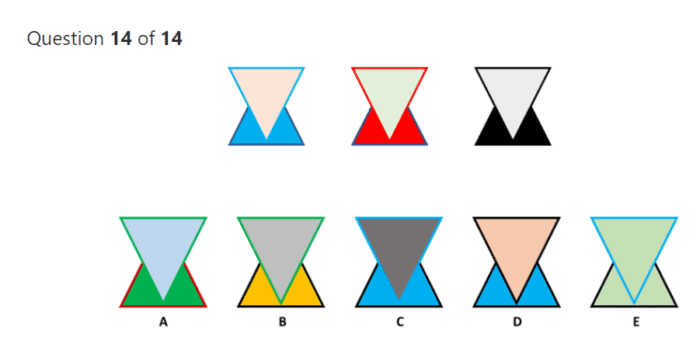
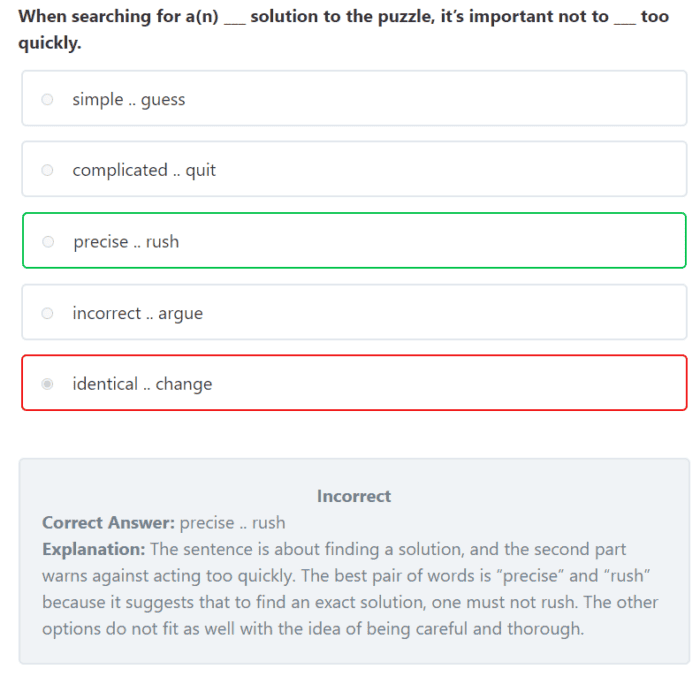
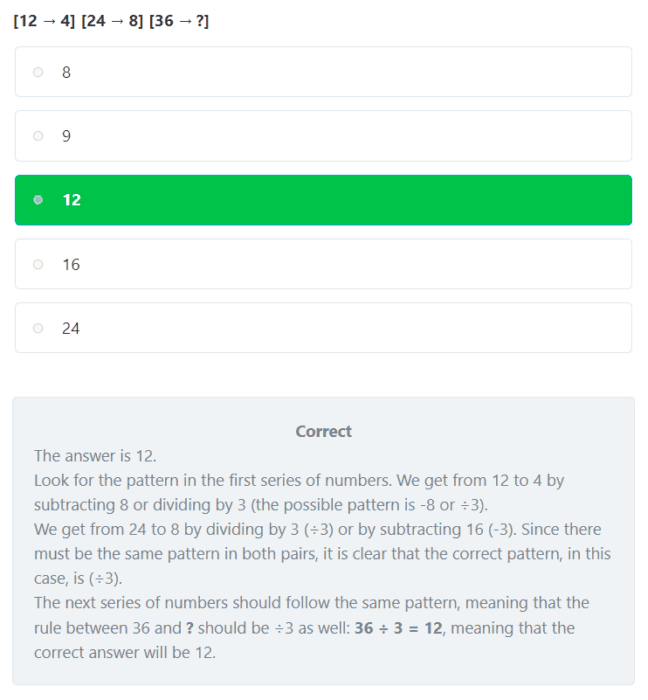
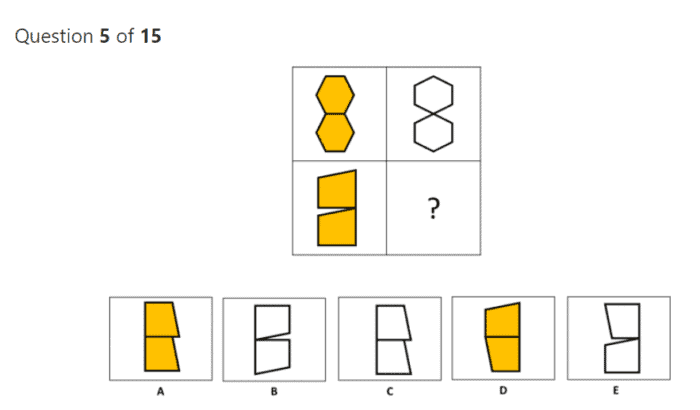
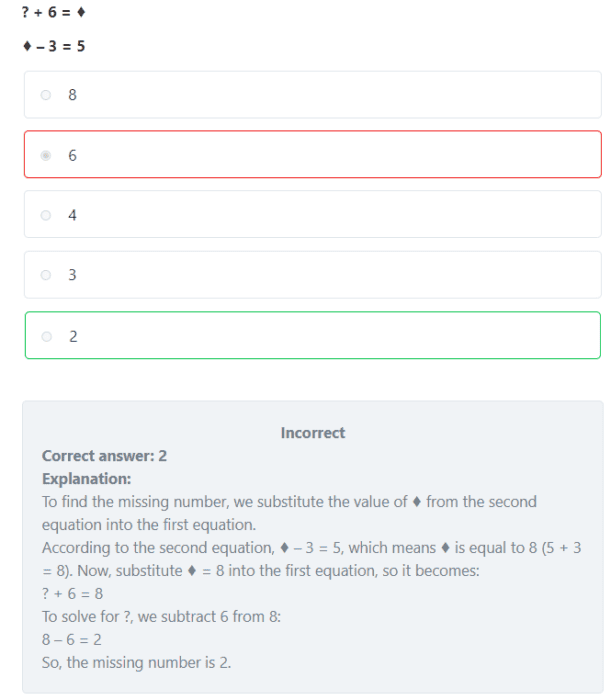
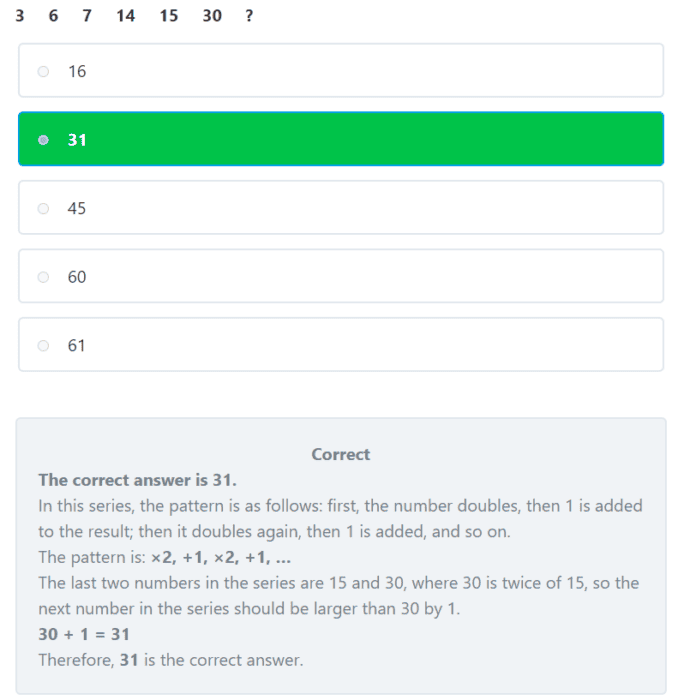
One-time Payment & 6-Month Unlimited Access
The CogAT Test for 3rd Grade is designed to assess students’ reasoning abilities and identify their potential for success in gifted and talented programs.
It consists of 170 questions and is tailored for students around 9 years old.
The test is divided into three main batteries: Verbal, Quantitative, and Nonverbal, each of which is further broken down into three subtests.
Schools have the flexibility to administer the three batteries either together on the same day or spread them out over multiple days, depending on their schedule and students’ needs.
See the table below for a detailed breakdown of the subtests within each battery.
| No. of Questions | Time Limits | |
|---|---|---|
| Nonverbal Battery | ||
| Figure Matrices | 20 | 10 minutes |
| Figure Classification | 20 | 10 minutes |
| Paper Folding | 16 | 10 minutes |
| Quantitative Battery | ||
| Number Analogies | 18 | 10 minutes |
| Number Series | 18 | 10 minutes |
| Number Puzzles | 16 | 10 minutes |
| Verbal Battery | ||
| Verbal Analogies | 22 | 10 minutes |
| Sentence Completion | 20 | 10 minutes |
| Verbal Classification | 20 | 10 minutes |
| Total | 170 Questions | 90 minutes (not incl. settling time) |
The complete practice package includes a full-length simulation with the same number of questions (170) and time limits (90 minutes). This will enable your child to get used to the test’s time pressure and improve their time management skills.
Many parents are told that “you can’t prepare” for cognitive ability tests like the CogAT—or that preparation might give students an unfair advantage.
However, the reality is that preparation isn’t about “teaching to the test.”
Instead, it helps students understand the test format, develop problem-solving strategies, and feel more confident when faced with unfamiliar types of questions.
Here’s why preparation is important:
Reduce Test Anxiety: Even bright students can feel overwhelmed by unexpected question types. Practice helps familiarize them with the format, easing stress on test day.
Learn How to Approach New Question Types: The CogAT presents challenges that students may not encounter in regular schoolwork, such as number puzzles or paper folding. Practicing these types of questions helps students build strategies to tackle them.
Sharpen Cognitive Skills: Preparation strengthens critical thinking, pattern recognition, and reasoning skills, all of which are useful not just for the test but for academic success in general.
Level the Playing Field: Students who practice are not learning “answers” but developing test-taking techniques—skills that help them perform to the best of their abilities, just like they would with any other important assessment.
Boost Confidence: Confidence comes with knowing what to expect. A student who is familiar with the test structure and has practiced similar questions will feel more capable and perform better.
Getting into gifted programs is competitive, and while natural ability plays a big role, adequate preparation ensures that your child’s true potential shines through on test day.
Your child deserves the best preparation to feel confident and perform their best on the CogAT test. That’s why we’ve created a thorough practice package tailored specifically to meet their needs.
Access 440+ practice questions across the Nonverbal, Quantitative, and Verbal batteries, designed to mirror the questions seen on the CogAT.
Build your child's confidence and abilities with targeted quizzes that focus on strengthening their knowledge in each of the 9 subject areas.
Boost your child’s problem-solving skills with advanced-level drills designed to stretch their abilities, making the actual test feel like a breeze.
One-time Payment & 6-Month Unlimited Access

Sharpening your child's skills with lifelike practice for gifted tests and school exams.
© 2025 GiftedReady | HTML Sitemap